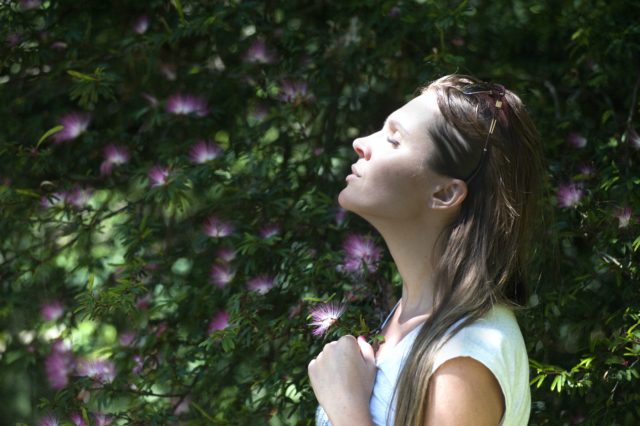I have often heard the suggestion that “people are naturally violent.” And while it is true that human beings do have an innate capacity for violent aggression, I do not believe humans are intrinsically prone to violence. That is, our natural desire is to be in a state of peace, and so our natural state should actually be said to be one of peace.
Now, this is not just some whimsical, hifalutin opinion I hold based on an idealistic hope for the world. Rather, my belief is based on both biological and social evidence. Below, I will present my case that human beings are naturally desirous of peace and are only prone to violence as a perceived or actual method of attaining peace. My argument will come from a micro (biological) perspective as well as a macro (societal) perspective. I will then discuss the role of a peacebuilder as that of a trained facilitator whose job it is to help people recognize their natural state and facilitate more peaceful ways of attaining it.
The Micro Argument: Biology Is Prone To Peace

The two most basic factors that indicate a thing is alive rather than not alive are: 1) it copies itself in some way (e.g., plants germinate, animate beings procreate), and 2) it must interact with its environment (e.g., plants photosynthesize, animate beings eat) to sustain life long enough to copy itself.
Peace is an Organism’s Naturally Desired State
In order to sustain life and thus its reproductive abilities, an organism strives toward a state of homeostasis because this is the most ideal state for such goals. Homeostasis or equilibrium is a state which indicates that all internal systems to the organism are cooperating and functioning effectively. That way the organism can survive and, presumably, reproduce, which is the fundamental drive of life. Living organisms’ primary striving toward balance or equilibrium is a foundational principle in biological science, and it implicates life’s most basic need and thus life’s most naturally desired state: balance, equilibrium, peace.
A quick note: total homeostasis is not the goal, as complete equilibrium would be “inanimation” or death. Animation of life requires energy, which requires friction, which cannot be achieved at complete rest. Hence, a state of peace, as I refer to it in this section on biology, shall imply a state as close to equilibrium as possible while maintaining the energetic friction necessary for life. Interestingly, organisms, including human beings, strive toward equilibrium but do need some friction, some challenge, some striving to be at a state that can be identified as peaceful.
An Organism Naturally Wants Peaceful Environments
Only in a state of peace can the organism sustain life longest and most optimally achieve its primary objective of copying itself. And because the organism must interact with the environment to sustain internal equilibrium, as prescribed by basic biological principles, the more equilibrium-supportive its environment is, the better. Hence, organisms thrive in environments that are peaceful and cooperative to that organism. In other words, environments that most optimally meet the organism’s fundamental needs.
Environments can meet these needs and be considered extremely peaceful by allowing for some energetic friction (challenges) but maintaining high-levels of safety and support. The more dangerous an environment (i.e. the more threatening to the organisms’ basic needs) or the more unsatisfying (the more unlikely to meet the organism’s needs), the greater likelihood the organism will not be at peace, which will significantly diminish its ability to sustain equilibrium and thus to reproduce. Hence, all organisms, including humans, want to be in peaceful environments. We strive toward creating and living in peace, so that we can be at a state of internal peace, which serves our fundamental needs and helps us live longer and more happily.
So Why Do We Create Violence, If Our Natural Inclination is Peace?
I have been referring to the concept of basic needs, which is integral to the discussion of peace and violence. All organisms have basic physiological needs — requirements for sustaining homeostasis and thus life. Some mammals, particularly more social mammals like primates, additionally have psychological needs. While a discussion of human’s psychological needs are beyond the scope of this article (see my article on basic human needs and conflict), it will suffice to suggest that human beings are driven or motivated to behave in ways that they believe will get their basic physiological and psychological needs met or in ways they believe will protect those needs from perceived threats.

While many living organisms, including plants and microorganisms, have the capacity to defend themselves in some way, not all living organisms do have defense mechanisms. And certainly, many do not have the capacities to aggress. This ability is typically reserved for predatory animals and social creatures. Human beings are, of course, social animals with the ability to aggress; but this fact does not negate our fundamental biological drive toward homeostasis. Human beings naturally want to be at peace, in balance, at equilibrium (even if we are not always conscious of this desire). Unfortunately, recognizing how to efficiently achieve equilibrium is not something that comes naturally to the human mind, and we are often taught ineffective, maladaptive, and even destructive methods toward achieving our goals.
In fact, human beings, like all living organisms that have the capacity to aggress, are only violent because they consciously or unconsciously perceive a threat to their basic needs and enter into a state of defense, OR because they are taught and thus believe they must aggress to get their or their group’s basic needs met. However, when an organism’s basic needs are satisfied, and when a human perceives his/her basic needs as being met, the organism naturally reclines to a state of rest, of equilibrium, of peace. The parasympathetic nervous system is engaged, calming the individual, allowing the organism to relax. While some stress (i.e. energetic friction) is necessary for total peace, a mostly relaxed state, rather than a chronically or exceedingly stressed state, is anecdotally and empirically proven to be more optimal for sustaining life and reproductive capacity.
Hence, all organisms, whether they are aware of it or not, want to be as close to equilibrium as they can get without being in total equilibrium, which would be death. In other words, there is a constant, innate biological drive to get as close to complete balance as possible. This is just as true for humans as it is for any other living organism. Likewise, all living organisms need to be supported by their environments, and so the more peaceful and equilibrium-supportive an environment, the more likely the organism is to maintain relative homeostasis. Again, this is true for humans as much as it is for any other organism. That being said, human environments are typically far more complex than those of other organisms. And because coming up with effective ways of attaining internal peace is not innate to human beings, not to mention that complex environments tend to make a clear path toward peace more difficult, human beings often come up with very maladaptive, often destructive (i.e., violent) ways they believe will get them to their goal of sustaining life and being at peace. Nonetheless, it is important to recognize that no matter how skewed or tainted our formulated methods of attaining goals, meeting needs, and achieving equilibrium actually are, peace is nonetheless our fundamental goal. We do want to be at peace, just like any other organism. We do want peaceful, equilibrium-supportive environments, just like any other organism. We cannot sustain internal peace in a chaotic, unpredictable, dangerous environment. And we cannot optimally survive or reproduce without internal equilibrium or external peace.
Hence, regardless of the state of our world or the circumstances within which we find ourselves, we should recognize that what we ultimately aim to achieve is peace around us and inside of us. Biology dictates this. We strive toward homeostasis. We strive toward creating equilibrium-supportive environments. But due to our complex worlds and intensely complex brains, we often run askew from effective, cooperative methods toward achieving our aims.
The Macro Argument: Society Has Become More Peaceful

Another sentiment I often hear expressed is: “The world is more violent than ever.” I can certainly understand this perspective, as we are increasingly faced with images of mass shootings, warfare, civilian casualties, sexual aggression, verbal bullying, and the like. But I would contend and studies do show that we are actually not more violent than ever but rather that we interface with more media than ever. And since media is more prone to display violence than it is peace (because human drama is interesting and thus creates ratings), the world only appears more violent than ever.
Violence Has Decreased
In fact, any study of global violence will show that now, more than ever before in human history, people are more tolerant, accepting, peaceful, and cooperative. Sound strange based on what you see in the media every day? Consider the middle ages, where homicide rates in Europe, for instance, were anywhere from 20-60 per 100,000 people (depending on the country) compared with 0.5 per 100,000 people in 2015, and has shown a steady decline century after century. Deaths by military efforts, including soldiers and civilians, have remained pretty consistent since the 14th century and began to decline only in the last 60 years or so, likely due to globalization and military technology. Life expectancy has steadily risen (from around 50-years-old to around 80-years-old) over the last century and has drastically risen (from around 30-years-old) over the previous several millennia. Obviously, advances in medicine have much to do with this. And these figures are true only for the modernized world. But those whose life expectancies are still low are not low due to violence, as it may have been in the past; rather, they are low due to disease and famine — non-violent (though nonetheless unfortunate) circumstances of the world.
Media Saturation Has Increased
So while violence has consistently decreased, the element that has dramatically increased is media coverage. Newspapers have only been widely distributed for about 100 years, and until 70 years ago, people had only radio and newspapers in their homes. They had extremely limited access to violent images, relative to today, which comprise the most salient aspect of witnessing violence. The average person in modern, industrial society began receiving regular TV images in nightly news in the 1950s. Then, almost 50 years later, came the internet in the late 1990s, which tremendously increased the amount and frequency of new, shared images from around the world. And only within the last decade have SMART phones exploded onto the human scene with the ability to capture images at will by all peoples everywhere and upload them for all people everywhere to view. And the most interesting things to capture, upload, and view are often, of course, human conflict. The reason for this intrigue around witnessing or watching human conflict is interesting and can be applied not just to news coverage but to all types of stories (i.e. movies, shows, plays, etc.); that topic, however, is beyond the scope of this article. The point is that while human violence has diminished, moving us on average steadily toward our naturally desired state of peace, it only seems not to have done so because of the incredible elevation of constant information from around the world, information that is consistently saturated with human conflict.
Despite what the media shows, the plain fact is that on average across the global population of 8 billion people, who spend approximately 128 billion combined waking hours each day alive on this planet, most of those hours are spent in peaceful cooperation. Only a very small percentage is actually spent engaged in violent endeavors. Unlike any other species on the planet, we are almost constantly cooperative with other individuals in our species, including strangers. Most of us walk down the street and smile or pay no attention to total strangers, rather than grow afraid and thus aggressive toward unknown others. This is not true for other species of social animals, and this has not always been true for human beings. But it is now.
Cultures Have Grown More Peaceful
Even though human aggression has drastically decreased, human beings have actually not changed much (at least not biologically or psychologically) since the dawn of civilization more than 10,000 years ago. We still have the same propensities and capacities. So what has changed that allows humans to be more at peace now more than ever before in history? Our cultures — we have different (and better) tools, systems, values, and beliefs which help us attain and sustain our naturally desired state of peace more of the time. Religion, law, education, government — all of these systems are set up to help engender more cooperation and less violence. At least, that was the basic premise in most of the modern world; even though these institutions are used by some to promote or justify violence, most adherents to these systems use them for peace. Indeed, those in modern, industrial societies have steadily been pushing our cultures toward becoming some of biology’s inherently optimal equilibrium-supportive environments.
This shift in culture over the centuries further reflects the fact that the vast majority of humans, even those regularly engaged in violence, do not actually want to be violent. We just want to be at peace. We want our families or cultural groups to be at peace. We only occasionally engage in aggression (some of us, unfortunately, more than others due to our location on the globe or our professions) because we believe aggression is a way back to peace. Those who are engaged regularly in violence, as well as those who only seldom become aggressive, do so because they are in a state of defense or because they have been taught and currently believe that aggression is the only way to attain and/or sustain peace for themselves or their groups. But ultimately, we all just want peace, even if the ways we believe we must attain it lead us to aggression.
These beliefs (e.g., aggression to attain peace) are not natural to the human being; rather, they are taught to us by our social environments. And so while the capacity for violence is indeed innate, desiring violence is not the nature of humans but rather the nurture. We learn to be violent. We are born, however, desiring equilibrium, desiring peace. Fewer than 1% of people are actually violent psychopaths, meaning they take some pleasure from violence and human suffering. Most people who are violent, even those who seem more regularly prone to violence, are not actually psychotic; on the contrary, they deeply want to be at peace. They may not even be aware of this fact anymore because they have been taught, and now they may have built an identity around the notion, that they must be aggressive or violent to attain internal peace. Nonetheless, unless they are actually violent psychopaths, they are just normal human beings — trying anything they can do to attain equilibrium, to attain peace. Sometimes, we just need some help attaining it more effectively.
The Role of a Peacebuilder: Reawakening Our Natural State

If human beings are actually naturally peaceful and only use violence because they are taught that aggression is one way or perhaps the “best” way of attaining or sustaining peace, then we can also unlearn these methods. It is possible to learn more productive, peaceful methods of attaining safety and getting our basic needs met. It is possible to replace the old violent methods. This process of relearning may be easier said than done, as many individuals who have been engaged in conflict for long periods end up building an identity with the conflict. But it can be done. And this is the job of a peacebuilder.
The peacebuilder’s role, as I see it, is threefold: 1) to help people recognize their natural desire for peace (the ultimate goal); 2) to facilitate the development and implementation of new, more peaceful methods of attaining and sustaining that goal; and 3) to help people change their identities (their beliefs about who they are) from ones who must be engaged in violent conflict to ones who can exist happily in peaceful cooperation.
So, as a peacebuilder, I aim first to help all parties become extremely clear on their ultimate goals. When we break down what conflicted parties think they want — drilling down beneath surface positions to deeper, underlying desires — we always arrive at the same basic desire, which can be expected based on the principles discussed in this article: everyone just wants to be happy and at peace. When all parties realize this — that they actually do not necessarily want to hurt each other but rather just find peace for themselves or their groups — they can finally perceive one another as existing on common ground, even possessing common goals.
Next is the process of helping the parties exit a conflict identity. That is, they do not have to think of themselves as parties in conflict. This is sometimes very difficult, especially with parties engaged in long-standing conflict. They have, over time, developed narratives around being in conflict that now seem to comprise who they are as people or as groups. Coming out of conflict and into a state of peace will require them to shift their conflict identities, to begin perceiving themselves differently, with new goals, values, and beliefs. They must replace their old life’s mission of “beating the other side” with some more peaceful, productive, and cooperative purpose. The latter mission can be just as if not more exciting and fulfilling. A peacebuilder will have to help show the parties this possibility so they may believe that peace, and a new peaceful identity, is actually possible and desirable. In order for any peacebuilding methodologies to be implemented, sustainable, and effective, the parties must believe that peace is possible, that it does not threaten their basic needs, and that on the contrary, it can satisfy needs even more effectively than the current conflict. This realization is the only way to assure parties will be motivated to engage in a peace process; that motivation is absolutely necessary to a successful peace process, including all the effort and discomfort that is involved. Transforming the conflict identity into a new identity of cooperative peace, as well as maintaining enough motivation to constructively participate in a process of peace, is applicable to couples and partners just as it is to larger groups of people.
Finally, a peacebuilder facilitates the construction (and sometimes implementation) of various methods to help parties build new, more effective and peaceful ways of getting their needs met. New methods will help the parties let go of old, maladaptive, destructive ways they have long believed are necessary to defend or satisfy their basic needs. The peacebuilder uses several tools to achieve this construction, such as a structured brainstorming session, workshops and panels, mediations, facilitated dialogues, and other methods. He will also sometimes act as a coach for ongoing support, a trainer for initializing ideas, a mediator for continued negotiations, a researcher for analyzing the effectiveness of utilized methods, and other multifaceted roles supporting the peace process.
Conclusion
To build peace, we must begin by illuminating the simple truth of human nature: We all want peace, but we often don’t know how to get there or stay there. If we recognize this fundamental point, we can build a more constructive path toward achieving our biologically driven, naturally desired states rather than remaining on more destructive, culturally-induced paths toward violence. Sometimes we need help to create and stay on those more constructive paths. But at least we can recognize that it’s possible and, in this peacebuilder’s humble opinion, more desirable.
If you need help resolving conflict and creating peace between individuals or groups, please do not hesitate to reach us at Pollack Peacebuilding. Our mission and passion are helping all peoples create more peace in the world.



